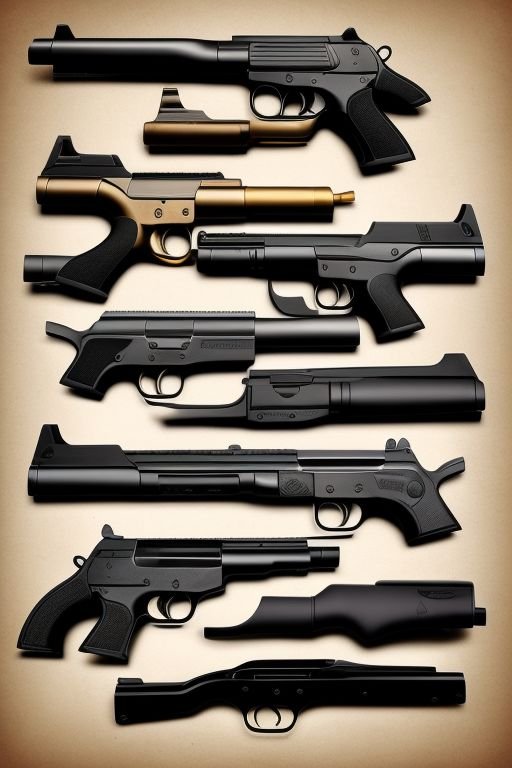Firearm
Types of Guns Explained: A Beginner’s Guide to Firearms
Understanding the different types of guns is essential for anyone interested in firearms, whether for self-defence, hunting, sport shooting, or military applications. Firearms come in various designs, each with specific features and functions determining their use and effectiveness. Knowing how they differ helps individuals make informed decisions about firearm safety, training, and legal ownership.
Guns serve multiple purposes. Handguns, such as pistols and revolvers, are commonly used for self-defence due to their compact size and ease of carrying. Rifles are favoured for hunting and long-range shooting, offering precision and power. With their widespread, shotguns are excellent for hunting birds and home defence. Meanwhile, Anatomy of a Bullet military and law enforcement personnel rely on specialized firearms like assault rifles and submachine guns for tactical situations.
This guide aims to provide beginners with a clear understanding of different gun types and their roles. By breaking down the key characteristics of each category, it aims to educate readers on firearm functionality, safety, and responsible ownership. Whether new to firearms or looking to expand your knowledge, understanding different kinds of guns is the first step toward responsible and informed use.
Main Categories of Firearms
Firearms are divided into several categories based on design, functionality, and intended use. Understanding these categories helps beginners identify the key differences between guns and their applications. The main types of guns include handguns, rifles, shotguns, submachine guns, machine guns, and speciality firearms.
Handguns (Pistols & Revolvers)
Handguns are small, easily portable firearms designed to be fired with one hand. They are commonly used for self-defence, law enforcement, and sport shooting.
- Pistols – Typically semi-automatic, pistols use a magazine to feed ammunition and are known for quick reloading and higher capacity.
- Revolvers – Feature a rotating cylinder that holds multiple rounds; they are reliable and straightforward, making them popular for personal defence.
Rifles
Rifles are long-barreled firearms designed for precision and long-range accuracy. They are used in hunting, sport shooting, and military operations.
- Bolt-action rifles – Require manual cycling of rounds and are favoured for hunting and sniping.
- Semi-automatic rifles – Fire one round per trigger pull and are popular for sport shooting and home defence.
- Assault rifles – Used by military forces, they can switch between semi-automatic and fully automatic firing modes (typically restricted for civilian use).
Shotguns
Shotguns fire shells loaded with pellets or slugs and are known for their powerful impact. They are used in hunting, sport shooting, and home defence.
- Pump-action shotguns – Require manual chambering of each round.
- Semi-automatic shotguns – Cycle rounds automatically for faster shooting.
Submachine Guns & Machine Guns
- Submachine guns – Compact automatic firearms that fire pistol-calibre rounds, often used in tactical operations.
- Machine guns – Fully automatic weapons with high fire rates, used primarily in military applications.
Specialty & Other Firearms
This category includes sniper, lever-action, derringers, and antique firearms, each designed for specific purposes.

Types of Handguns
Handguns are compact, lightweight firearms designed for one-handed use. Due to their portability and ease of handling, they are popular for self-defense, law enforcement, and sport shooting. The two main types of handguns are pistols and revolvers, each with distinct characteristics.
Pistols
Pistols are semi-automatic handguns that use a magazine to feed ammunition into the chamber. They fire one round per trigger pull and automatically reload the next round, making them efficient and fast for type of handgun gun self-defence and law enforcement. Pistols typically have higher ammunition capacity (ranging from 6 to 17 rounds or more) and are easier to reload than revolvers. Popular models include the Glock 19, Smith & Wesson M&P, and Sig Sauer P320.
Revolvers
Revolvers use a rotating cylinder-based mechanism to hold and fire rounds. Unlike pistols, they require manual cocking in some models (single-action) or have a heavier trigger pull (double-action). Revolvers are highly reliable, with fewer mechanical failures than pistols, making them a preferred choice for some self-defence users and collectors. However, different type of guns they have lower capacity (usually 5-7 rounds) and take longer to reload. Examples include the Colt Python, Ruger GP100, and Smith & Wesson Model 686.
Comparison of Handguns
Pistols offer higher capacity, faster reloads, and lighter triggers, while revolvers are valued for simplicity, durability, and reliability. The best choice depends on the user’s preference, experience, and intended use.
Types of Rifles
Rifles are long-barreled firearms designed for accuracy and power, ideal for hunting, sport shooting, law enforcement, and military applications. They fire a single projectile per round and come in various types, each suited for specific uses. The three primary types of rifles are bolt-action rifles, semi-automatic rifles, and assault rifles (military-grade).
Bolt-Action Rifles
Bolt-action rifles are manually operated, requiring the shooter to cycle the bolt after each shot to load the next round. This design makes them highly reliable, precise, and robust, making them a top choice for hunting, types of weapons long-range shooting, and sniper operations. They typically have lower magazine capacities (around 4-10 rounds), but their precision outweighs their slower firing rate. Popular models include the Remington 700, Winchester Model 70, and Tikka T3x.
Semi-Automatic Rifles
Semi-automatic rifles fire one round per trigger pull, automatically reloading the next round. Due to their rapid-fire capability and ease of use, they are widely used for sport shooting, home defense, and law enforcement. These rifles often have higher-capacity magazines (10-30 rounds) and are favoured for their versatility. Popular semi-automatic rifles include the AR-15, Ruger 10/22, and AK-47 (civilian versions).
Assault Rifles (Military-Grade)
Assault rifles are fully automatic or burst-fire capable firearms used by military and special forces. They allow multiple rounds to be fired with a single trigger pull, making them highly effective in combat situations. Due to their high firepower and rapid rate of fire, assault rifles are strictly regulated and generally not available for civilian use. Examples include the M4 Carbine, AK-47, and FN SCAR.
Each type of rifle serves a distinct purpose, and understanding their capabilities helps users choose the right firearm for their needs.
Specialty & Other Firearms
Speciality firearms are designed for unique purposes beyond standard handguns, rifles, and shotguns. These include sniper, lever-action, and small, concealable handguns like Derringers and pocket pistols. Each firearm has distinct characteristics that set them apart from conventional guns.
Sniper Rifles
Sniper rifles are high-precision, long-range firearms used by military snipers, law enforcement sharpshooters, and long-distance sport shooters. They are typically bolt-action to ensure accuracy, but some models are semi-automatic for faster follow-up shots. These rifles use high-powered scopes and specialized ammunition to hit targets at extreme distances, often beyond 1,000 yards. Popular sniper rifles include the Barrett M82, Remington 700, and Accuracy International AX50. Their precision and range make them invaluable for military and police operations and competitive shooting.
Lever-Action Rifles
Lever-action rifles are classic firearms known for their distinctive lever-cycling mechanism. Popular in the late 19th and early 20th centuries, they were used by cowboys, hunters, and law enforcement officers. Lever-action rifles offer moderate capacity (5-10 rounds) and a smooth firing sequence, making them excellent for hunting and sport shooting. Some famous models include the Winchester Model 1894, Marlin 336, and Henry Golden Boy. These rifles remain popular among enthusiasts who appreciate their historical significance and reliability.
Derringers & Pocket Pistols
Derringers and pocket pistols are small, highly concealable handguns designed for personal defence. Derringers typically have two barrels and hold one or two rounds, while modern pocket pistols can hold 6 to 10 rounds in a compact frame. Due to their lightweight and discreet size, they are ideal for concealed carry. Popular examples include the Bond Arms Derringer, Ruger LCP, and Smith & Wesson Bodyguard 380.
These speciality firearms serve specific roles, offering users precision, historical appeal, or discreet personal protection.
Choosing the Right Firearm
Selecting the right firearm requires careful consideration of several factors, including purpose, ease of use, calibre, and legal restrictions. Each firearm serves a distinct function, whether for self-defence, hunting, sport shooting, or professional use, and choosing the most suitable one enhances safety and effectiveness.
The purpose of the firearm is the first and most important factor. A handgun is ideal for concealed carry and self-defence, while a rifle is better suited for hunting or long-range shooting. Shotguns are preferred for home defence and certain types of hunting.
Another critical aspect is ease of use. Due to their reliability and straightforward operation, revolvers and bolt-action rifles may be simpler for beginners, while semi-automatic handguns and rifles require more familiarity with reloading and maintenance.
Calibre selection impacts recoil, stopping power, and ammunition costs. Lower calibres like .22 LR are great for beginners and target shooting, while higher calibres like .45 ACP or .308 Winchester are more powerful but require better handling skills.
Legal restrictions vary by location, so understanding firearm laws and permits is essential. Also, proper training and responsible gun ownership are crucial to ensure safety, accuracy, and law compliance. Investing in training helps firearm owners use their weapons effectively while minimizing risks.
Conclusion
Understanding the different kinds of guns and their purposes is essential for anyone interested in firearms. Each firearm serves a specific role, whether it’s a handgun for self-defence, a rifle for hunting or sport shooting, or a shotgun for home protection. Additionally, speciality firearms like sniper, lever-action, and Derringers cater to unique needs and preferences.
For beginners, choosing the right firearm requires thorough research and careful consideration of factors such as intended use, ease of handling, calibre, and legal restrictions. It’s important to remember that owning a firearm is a responsibility that extends beyond simply purchasing a gun. Training, practice, and adherence to safety guidelines are crucial to becoming a responsible gun owner. Enrolling in firearm safety courses, visiting shooting ranges, and consulting experts can significantly improve confidence and skill.
Safety should always be the top priority. Proper handling, secure storage, and knowledge of firearm laws are non-negotiable aspects of gun ownership. Understanding how to operate a firearm correctly and legally ensures not only personal safety but also the safety of those around you.
In conclusion, firearms are potent tools that require respect, responsibility, and proper training. Whether for self-defence, hunting, sport shooting, or professional use, making an informed choice is key to safe and effective firearm ownership.


